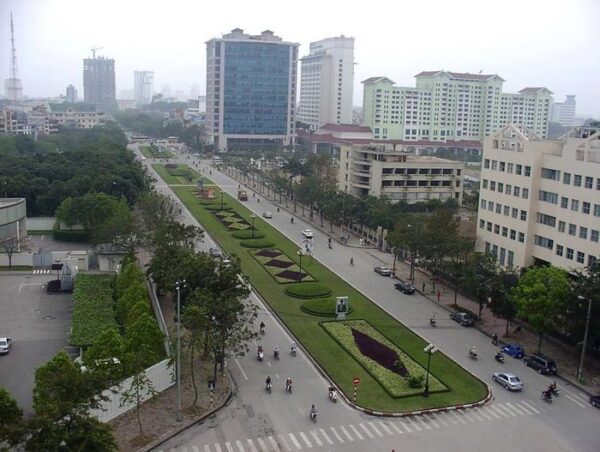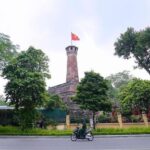
Lieu Giai Street, Ba Dinh District. Photo: Thanh Hai
The old architectural space is gradually disappearing
Ba Dinh district is formed from specific areas, including the capital area, a part of the old European-style quarter and the area of 13 villages (Thập tam trại) in Ngoc Ha, Doi Can, Lieu Giai, Vinh Phuc, Cong Vi, Ngoc Khanh, Giang Vo, Kim Ma, Thanh Cong, etc. wards).
Based on map of Thang Long in the Hong Duc reign and the map of Hanoi province in the Dong Khanh geography, it could be seen that the area of 13 villages covered mainly by water surface, ponds and lakes, the water surface area was quite large. On the map of Hanoi at the beginning of the 19th century, the residential areas had been developed concentratedly into villages with a system of rivers, lakes, ponds, trees, garden until the French built the streets and administrative center on this area.
During the system of budget subsidies, this area still retained the characteristics of traditional villages with the space of water wells, communal yards, large land plots for gardens, fish ponds, most of the buildings only about 1-2 floors high, low construction density.
The process of urbanization with the rapid increase in population led to the division of land plots into smaller lots to build houses for many generations, high construction density. Vacant land areas (agricultural land, ditch, pond, etc.) were encroached upon, leveled; orchards were demolished for housing construction, etc. Since then, a small, zigzag traffic system was formed; infrastructure, drainage, lighting system were almost absent, the traditional village structure was gradually disappeared.
The State management of planning and construction using insufficient and weak management tools made the impact of urbanization on the area of 13 villages even more difficult to control. The village structure gave way to spontaneously-formed tube houses with small areas (width of 3 – 4m and length of 7 – 15m), which were built closely along the small alleys 1.5m- 2.5m wide; technical infrastructure has not kept pace with population development; Trees, social infrastructure are even more distant from people’s needs. As the same as planning, architecture also lacks control, so traditional architectural values are lost.

Map of Ba Dinh district
One of the features associated with villages for a long time is the relics, religions – beliefs such as communal houses, temples, pagodas, shrines, clan ancestral houses, etc., area of 13 villages is not the exception. In general, these works have historical values, beautiful architecture, closeness and attachment to life because they stem from the religious and spiritual needs of the villagers, been built mainly from contribution of villagers.
However, most of these structures have been degraded. Moreover, some works are encroached on space. According to the survey, many of them are national and city-level heritages, and have historical and cultural values. The conservation of them is only the maintenance to preserve the rest of the works. In addition, acquisition and clearance the ground to return the space of these relics have not been done yet..
Many conservation solutions
To revive the area of 13 old farm villages, Ba Dinh district has proposed to make a detailed planning 1/500 of the area of 13 villages and establish a set of tools for management of space and landscape architecture, to strictly manage the height and scale of houses from 3 to 4 floors, to control construction density as low as 60%, etc. During the process of granting construction permits, related agencies encourages people to have setback during their construction by themselves to create an open space in front of the house.
In addition, public investment projects renovate and develop green spaces – water surfaces, widen roads in villages (minimum 4m). It is not allowed to convert green land, water surface, vacant land, etc. into construction land. Prioritize the arrangement of communal works, flower gardens, playgrounds, parking lots, garbage collection points that are hygienic and aesthetically pleasing. Establish management regulations for each specific area, paying special attention to village institutions (village gates, village wells, etc.).
Besides, with the desire to restore the nuclear elements that make up the spatial structure of the old villages, many relics of communal houses, temples, pagodas, shrines, etc are also planned by the district for site clearance and renovation. The total annual investment for this accounts for 20-40% of the total public investment plan of the district.

Flag Tower of Hanoi (Photo: Duy Khanh)
There are many difficulties, such as the mechanism and policy in land clearance, the inadequacy of management records over many periods, many legal changes about resettlement, etc. But the biggest challenge is the awareness of people about the values that are gradually being lost, so restoring the values of the 13 old villages needs the consent of the people.
With drastic solutions, from now to 2025 and the following years, Ba Dinh district will basically control the space, landscape architecture, high floors, construction density of residential areas, villages and houses which are available in this area of 13 old villages.
Up to now, Ba Dinh district has implemented 45 projects, including 6 monuments ranked at national level; 14 city-level monuments; Especially, there are 2 works belonging to “Thang Long Tu Tran”, Quan Thanh Temple and Voi Phuc Temple (ranked as a special national relic in 2022).From 2012 to 2022, the district has relocated 350 households from protected area 1 of listed historic sites.
PhD. Architect Ta Nam Chien – Chairman of Ba Dinh District People’s Committee

